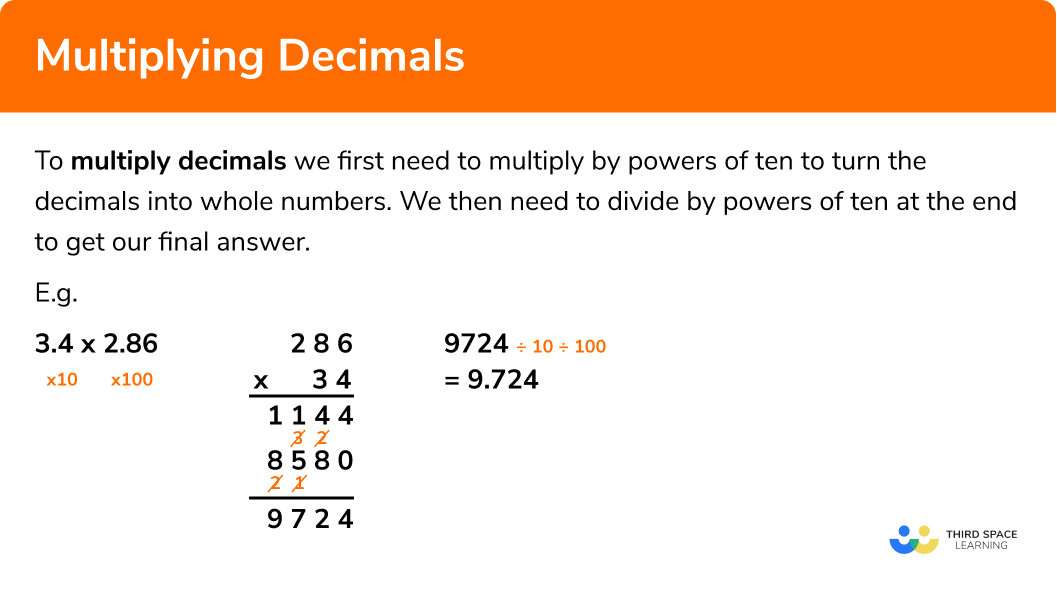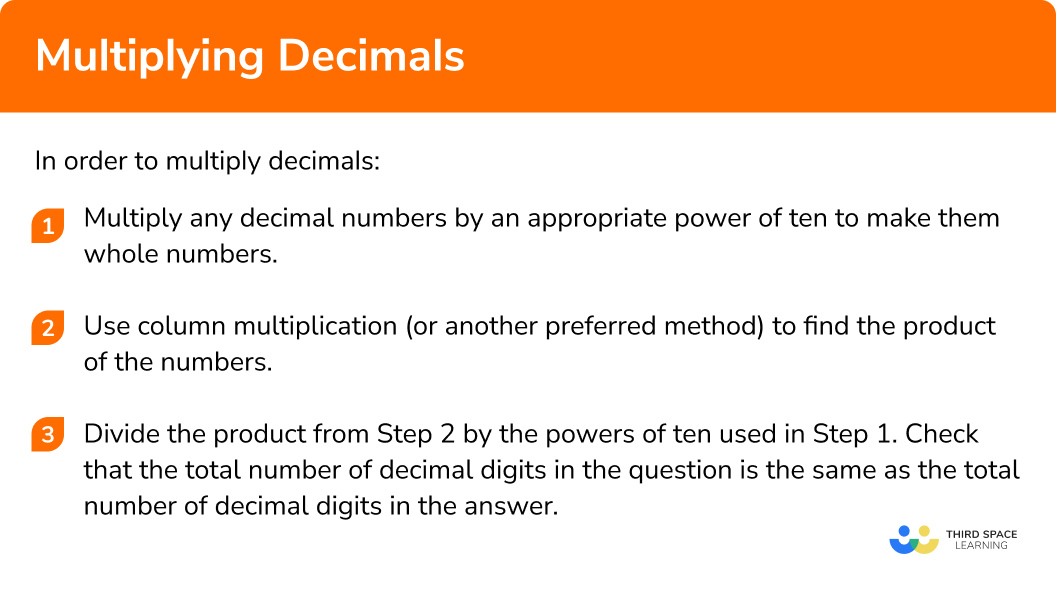One to one maths interventions built for KS4 success
Weekly online one to one GCSE maths revision lessons now available
In order to access this I need to be confident with:
Place value Decimals Arithmetic Money problems mathsThis topic is relevant for:

Multiplying Decimals
Here we will learn about multiplying decimals including how to multiply decimals by a whole number and multiply decimals by decimals.
There are also multiplying decimals worksheets and word problems based on Edexcel, AQA and OCR exam questions, along with further guidance on where to go next if you’re still stuck.
What is multiplying decimals?
Multiplying decimals is where we multiply together decimal numbers.
To multiply decimals we first need to multiply by powers of ten to turn the decimals into whole numbers. We then need to divide by powers of ten at the end to get our final answer.
Multiplying decimals is important when dealing with money problems such as the conversion of currency. It is also a vital skill when converting between metric units and other multiplication problems.
E.g.
What is multiplying decimals?

Recap of multiplying and dividing by 10, 100, 1000…
When solving problems where we need to multiply or divide decimals, we need to multiply and divide by powers of ten.
When we multiply by a power of ten, each digit increases in place value.
If we multiply by
E.g.
If we divide by
E.g.
How to multiply decimals
To multiply decimals we will multiply by powers of ten at the start, and then divide by powers of ten at the end to get our final answer.
In order to multiply decimals:
- Multiply any decimal numbers by an appropriate power of ten to make them whole numbers.
- Use column multiplication (or another preferred method) to find the product of the numbers.
- Divide the product from Step 2 by the powers of ten used in Step 1. Check that the total number of decimal digits in the question is the same as the total number of decimal digits in the answer.
Explain how to multiply decimals in 3 steps


Multiplying decimals worksheet

Get your free multiplying decimals worksheet of 20+ questions and answers. Includes reasoning and applied questions.
DOWNLOAD FREE
Multiplying decimals worksheet

Get your free multiplying decimals worksheet of 20+ questions and answers. Includes reasoning and applied questions.
DOWNLOAD FREERelated lessons on decimals
Multiplying decimals is part of our series of lessons to support revision on decimals. You may find it helpful to start with the main decimals lesson for a summary of what to expect, or use the step by step guides below for further detail on individual topics. Other lessons in this series include:
Multiplying decimals examples
Example 1: multiplying an integer by a decimal
Work out
- Multiply any decimal numbers by an appropriate power of ten to make them whole numbers.
Multiply
2Use column multiplication (or another preferred method) to find the product of the numbers.
3Divide the product from Step 2 by the powers of ten used in Step 1. Check that the total number of decimal digits in the question is the same as the total number of decimal digits in the answer.
In Step 1 we multiplied
Check that the total number of decimal places in the question matches the total number of decimal places in the answer.
The answer is
Example 2: multiplying an integer by a decimal
Work out
Multiply any decimal numbers by an appropriate power of ten to make them whole numbers.
Multiply
Use column multiplication (or another preferred method) to find the product of the numbers.
Divide the product from Step 2 by the powers of ten used in Step 1. Check that the total number of decimal digits in the question is the same as the total number of decimal digits in the answer.
In Step 1 we multiplied
Check that the total number of decimal places in the question matches the total number of decimal places in the answer.
The trailing zero can now be removed.
The answer is
Example 3: multiplying a decimal by a decimal
Work out
Multiply any decimal numbers by an appropriate power of ten to make them whole numbers.
Multiply
Use column multiplication (or another preferred method) to find the product of the numbers.
Divide the product from Step 2 by the powers of ten used in Step 1. Check that the total number of decimal digits in the question is the same as the total number of decimal digits in the answer.
In Step 1 we multiplied
1
Check that the total number of decimal places in the question matches the total number of decimal places in the answer.
The answer is
Example 4: multiplying a decimal by a decimal
Work out
Multiply any decimal numbers by an appropriate power of ten to make them whole numbers.
Multiply
Use column multiplication (or another preferred method) to find the product of the numbers.
Divide the product from Step 2 by the powers of ten used in Step 1. Check that the total number of decimal digits in the question is the same as the total number of decimal digits in the answer.
In Step 1 we multiplied
Check that the total number of decimals in the question matches the total number of decimals in the answer.
The answer is
Common misconceptions
- Decimal point in the wrong position in the answer
It is very common for the answer to have the decimal point in the wrong position. It is important to remember the powers of ten that were used at the start in order to reverse them to calculate the final answer.
Checking that the total number of decimal places in the question is the same as the total number of decimal places in the answer is a way to avoid having the decimal point in the wrong position.
Also rounding the numbers in the question to
E.g.
Practice multiplying decimals questions
1. Multiply together 6 and 2.8




Work out 6\times28 and then divide the answer by 10
2. Work out 9.4\times16




Work out 94\times16 and then divide the answer by 10
3. Work out 23\times0.17




Work out 23\times17 and then divide the answer by 100
4. Multiply together 5.6 and 9.8




Work out 56\times98 and then divide the answer by 100
5. Find the product of 4.83 and 7.2




Work out 483\times72 and then divide the answer by 1000
6. Work out 2\times3.7\times1.54




Work out 2\times37\times154 and then divide the answer by 1000
Multiplying decimals GCSE questions
1. You are given that 132\times451 = 59532 . Use this information to work out the following:
(a) 13.2\times451
(b) 1.32\times4.51
(c) 13.2\times0.451
(3 marks)
(a) 5953.2
(1)
(b) 5.9532
(1)
(c) 5.9532
(1)
2. (a) Find the cost of 12 bottles of sparkling water costing £1.69 each.
(b) At a cinema, adult tickets cost £7.75 and child tickets cost £5.49 . Find the total cost of 5 adults and 7 children
(5 marks)
(a) 12 \times 169
(1)
£20.28 i
(1)
(b) 5 \times7.75 or 7\times5.49
(1)
38.75 or 38.43
(1)
Correct answer of £77.18
(1)
3. Calculate the area of the rectangle
(2 marks)
12.4\times8.7 i
(1)
107.88 i
(1)
Learning checklist
You have now learned how to:
- Understand and use place value for decimals, measures and integers of any size
- Use the four operations, including formal written methods, applied to integers, decimals, proper and improper fractions, and mixed numbers, all both positive and negative
The next lessons are
Still stuck?
Prepare your KS4 students for maths GCSEs success with Third Space Learning. Weekly online one to one GCSE maths revision lessons delivered by expert maths tutors.

Find out more about our GCSE maths tuition programme.